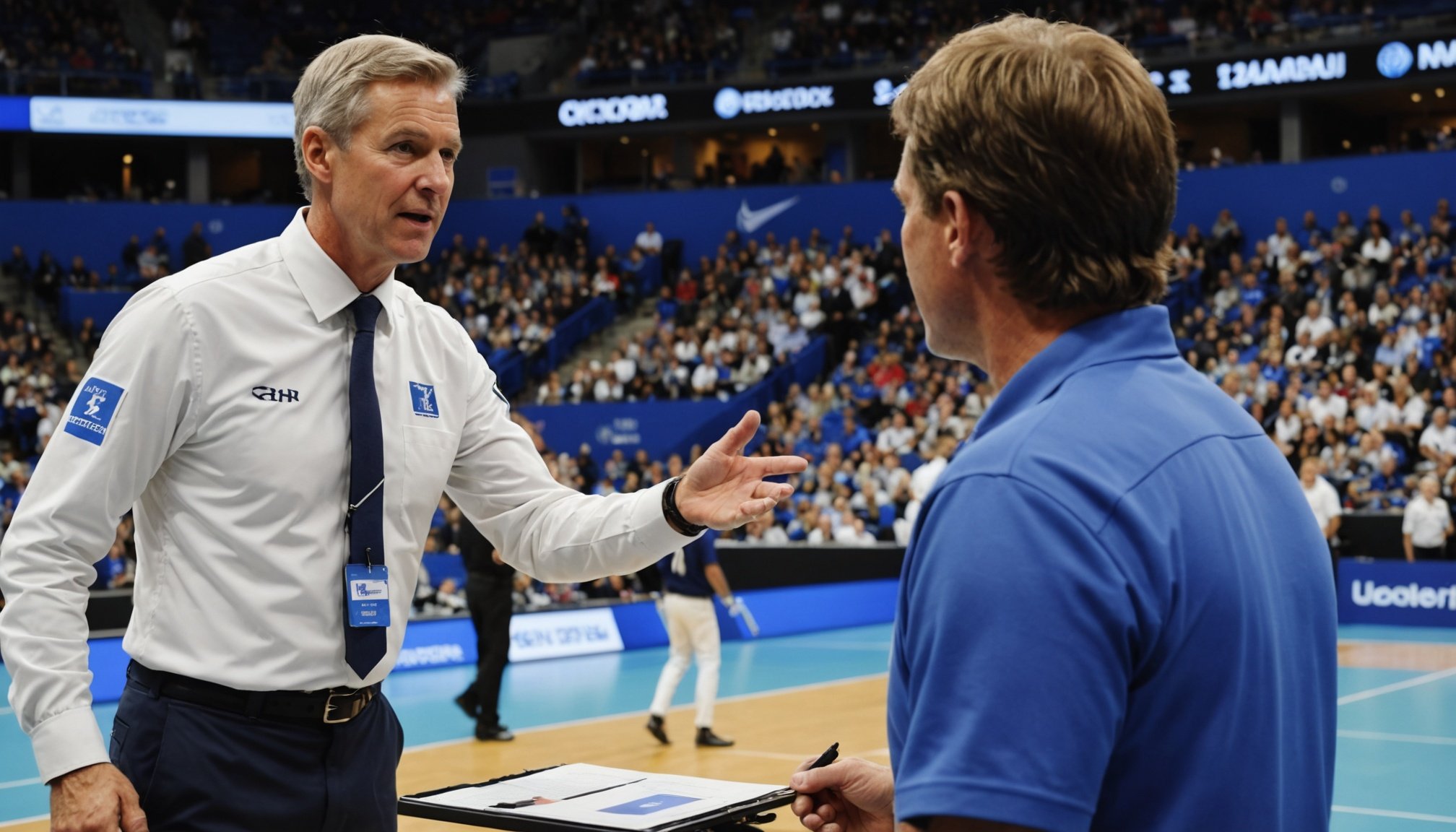Overview of Video Replay Technology in Fencing
Video replay technology is revolutionising the way decisions are made in sporting events, including fencing. At its core, this technology allows officials to review footage in slow motion to ensure that calls made during a match are accurate. These replays help enhance the fairness and precision of officiating by providing visual evidence to support match decision-making.
In sports, video replay technology was first introduced in American football in the 1980s, setting a precedent for its use in other sports worldwide. Specifically, in fencing, its adoption aimed to tackle the prevalent issue of erroneous calls, thereby improving the integrity of match outcomes. The replay system focuses particularly on verifying actions like valid hits and points scored, which can drastically affect the game’s outcome.
This might interest you : Empowering diversity and inclusion in uk secondary school sports: creative approaches for lasting impact
The adoption rate of video replay technology in the UK’s fencing community has been gradually increasing over the past few years. This increase is a testament to the fencing community’s commitment to maintaining high officiating standards and encouraging fair play. British Fencing has actively promoted the use of this technology during national tournaments to enhance objectivity and transparency in fencing officiating. This advancement highlights a broader trend of embracing technological solutions in sports to improve the quality of decision-making.
Benefits of Video Replay for Match Officiating
Video replay technology introduces numerous benefits to match officiating, significantly improving the accuracy of decisions. By providing officials with an opportunity to review actions in real-time, human error is reduced. This technological advancement ensures that decisions are made with greater precision, minimising the risk of incorrect calls that could alter the outcome of games.
Also to read : Elevate your game: essential tips for uk beach volleyball players to master the sand court
Not only does video replay enhance the accuracy in officiating, but it also promotes fairness and transparency within sports. Players and spectators alike can observe the decision-making process, providing clarity and understanding of why particular calls are made. This transparency also helps ensure that all teams are subjected to consistent and unbiased officiating.
Furthermore, the use of video replay bolsters the confidence of both referees and athletes. For referees, having access to multiple angles and slow-motion reviews empowers them to make more informed decisions, alleviating the pressure of split-second judgments. For athletes, knowing that a robust review system is in place offers reassurance that the game is being officiated fairly.
In summary, integrating video replay into match officiating encourages a smoother, fairer, and more reliable decision-making process, benefiting the entire sports community.
Case Studies: UK Coaches Implementing Video Replay
Understanding the effectiveness of video replay requires a deep dive into real-world case studies that demonstrate how UK coaches have navigated this tool’s implementation.
Success Stories
UK coaches who have fully embraced video replay implementation often report enhanced player insights and performance. For instance, one football team used video replay to analyse their defensive tactics, leading to a remarkable 30% increase in successful interceptions in the following season. Another coach in rugby employed video review sessions to fine-tune players’ techniques, resulting in a noticeable improvement in overall team cohesion and individual skills.
Challenges Faced
However, the path to success is not without hurdles. Among the common challenges is resistance to change among traditionalists who are sceptical of incorporating new technologies. This mindset can initially impede the integration process, as players and staff may require additional time and training to adapt. Furthermore, technical issues such as poor video quality or outdated equipment can limit the effectiveness of the replays.
Lessons Learned
From these case studies, several important lessons emerge for coaches considering video replay.
- Engaging the whole team in the adaptation process fosters acceptance and enthusiasm.
- Addressing potential resistance through education on the benefits can smooth the transition.
- Ensuring high-quality equipment and technical support is critical for reaping the full rewards of video replay.
Ultimately, these experiences provide valuable insights into effectively utilising this digital tool in sports coaching.
Expert Opinions on Video Replay in Fencing
The role of technology in sports has been transformative, and fencing is no exception. Fencing referees and officials provide critical insights into how video replay has enhanced decision-making processes. Historically, fencing matches relied solely on the judgment of on-site referees, which sometimes led to controversial calls. Video replay now offers an additional layer of accuracy by allowing referees to review actions in detail, thus increasing the precision of their calls.
Expert opinions suggest that while video replay has significantly improved fairness, it is essential for referees to receive comprehensive training on its use. This ensures they can efficiently utilise the technology without disrupting the flow of the match. Some fencing referees express concerns about over-reliance on replays, advocating for a balance between technological aids and traditional refereeing skills.
Future developments in sports technology promise even more innovation. Experts anticipate advancements in automatic scoring systems and AI-integrated video replay, which could refine the evaluation process further. As technology continues to evolve within the officiating landscape, the role of referees is likely to shift from decision-makers to supervisors overseeing technology-guided processes, ensuring that the human element remains prevalent in sports.
Potential Challenges of Integrating Video Technology
Integrating video technology into fencing officiating brings both promise and potential pitfalls. One of the primary challenges in video technology is its technical complexities. Video systems must deliver precise images in real-time; however, existing technology often falls short, presenting limitations that can affect decision accuracy. Frequent malfunctions or lags may impede quick decisions, critical in the fast-paced environment of fencing.
Another significant hurdle is training. Referees and staff require extensive training to effectively utilise video technology, which includes understanding the nuances of video analysis and learning to operate sophisticated systems. This training can be both time-consuming and costly but is crucial to ensure consistent and correct application during matches.
Moreover, there’s a growing concern about over-reliance on technology. While video can provide valuable insights, an over-dependency might lead to decision fatigue. Referees could spend excessive time deliberating over video analysis, disrupting the tempo of the match and leading to potential biases in judgment. It’s vital to balance technology use with traditional refereeing skills to maintain the integrity of the sport.
Addressing these implementation hurdles requires careful consideration and a strategy that combines technical enhancement, comprehensive training programs, and policy changes to mitigate over-reliance on video technology.
Future Implications of Video Replay Technology
As we look ahead, the future of officiating in fencing is poised for transformation through technology trends in sports. Innovations in video replay technology are set to refine the precision and fairness of this historic sport.
Video replay is anticipated to evolve, offering even more nuanced insights into competitive bouts. For instance, advancements like multi-angle cameras and high-speed analysis tools could supply referees with comprehensive views of actions, reducing human error and subjectivity. As a result, we can expect a rise in officiating standards, ensuring more consistent and equitable judgement.
In terms of athlete performance, such technological progress could encourage fencers to adapt by incorporating strategic play that aligns with the precise capabilities of enhanced technology. This shift might necessitate a deeper understanding of movement and timing, reinforcing the importance of technical perfection and mental acuity in fencers.
Moreover, fencing innovation through these technologies may reshape the competitive landscape, fostering an environment where technology and skillset are intricately linked. Such evolution would not only enhance the spectator experience but also broaden the sport’s appeal, welcoming a new generation of enthusiasts and participants to the world of fencing competition.











